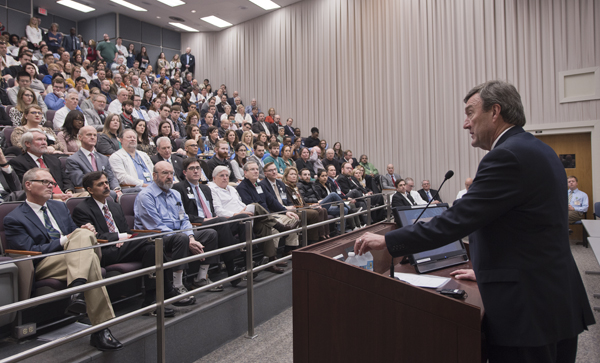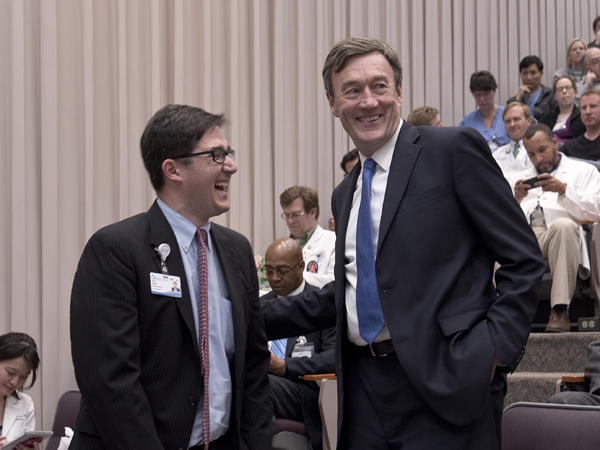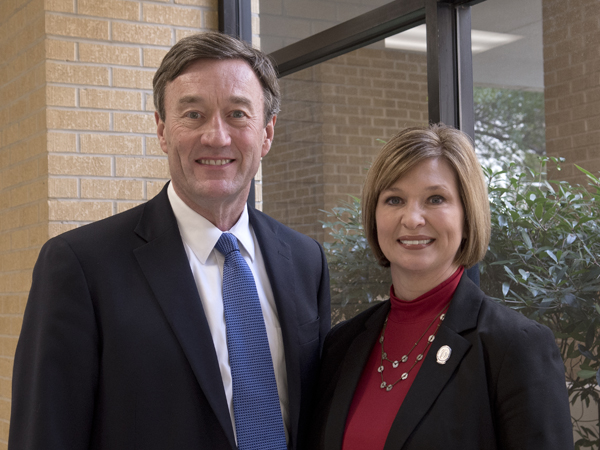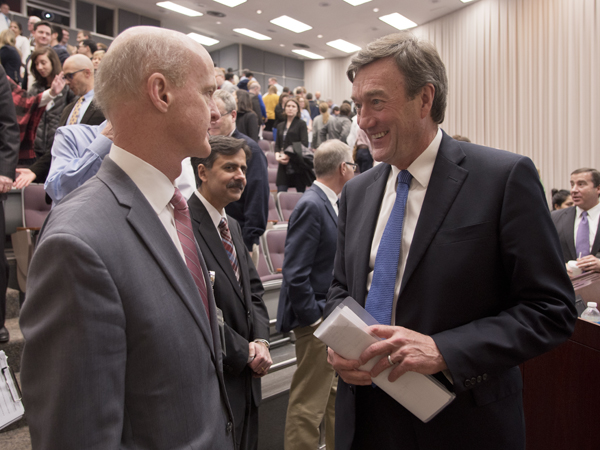Mayo Clinic’s leader shares building blocks for future of medicine

Published in News Stories on January 11, 2016
The future of medicine lies in the hands of those who care for patients and who put their needs first, one of the country's most prominent health-care leaders says.
“You have the mission - that commitment to the people of Mississippi -- and it is really, really powerful,” Dr. John Noseworthy, professor of neurology and president and CEO of the Mayo Clinic, told an overflow crowd Friday during a Grand Rounds presentation open to all faculty, staff and students.
“The future of medicine starts with the people, and the people I've met in the last couple of days here (at UMMC) are going to put us in a very good place.”
UMMC leadership asked Noseworthy to address the future of medicine because it's so critical to the current status of health care, said Dr. Richard Summers, professor of emergency medicine and associate vice chancellor for research.

Noseworthy (right) shares a laugh with Dr. Peter Arnold, associate professor of plastic surgery.
Noseworthy's visit also puts a spotlight on the special partnership shared by the Mayo Clinic and UMMC. The two entities formed an institutional bond in 2010, and in 2014 committed to broadening and deepening their collaboration in clinical trials, medical research and education. The agreement is a formal commitment to enhance the relationship that has been steadily building for the past 20 years, a collaboration that will be transformational for the Medical Center across its missions of research, education and health care.

Noseworthy, left, and Woodward
“We are excited about the possibilities that can come forward from this relationship,” Dr. LouAnn Woodward, vice chancellor for health affairs and dean of the School of Medicine, said before Noseworthy's presentation. “It's a real game-changer for Mississippi.”
A Massachusetts native, Noseworthy came to the Mayo Clinic in 1990, joining its board and becoming president and CEO in 2009. Every year, more than a million people from across the nation and about 140 countries seek specialized care at the Mayo Clinic, which operates in six states, houses the Mayo Medical School, and is dedicated to medical care, research and education.
Noseworthy, former chair of Mayo's Department of Neurology, said his clinic and UMMC have many things in common in addition to a commitment to patients. The Mayo Clinic has 4,200 physicians and scientists, 2,400 residents and fellows, and 60,000 employees compared to UMMC's approximately 10,200 employees.
Even so, he said, “at our heart, we're very much like you. You're innovative. It all comes down to what you and the patient do to keep them well and to support them.”
Like UMMC, the Mayo Clinic has its share of patients with limited ability to pay for their care. “Fifty-two percent of Mayo patients are on Medicare or Medicaid, and about 60 percent of what we do is for a population that pays us 56 cents on the dollar,” Noseworthy said. “You are charitable, but you can't be a charity hospital because you have to fund your staff. You have to fund your future.”
As his clinic looks ahead, he said, it continues to lead by following four tenets: deliver knowledge, create value, invest in excellence, and partner with others.
Just one example: Mayo is sharing knowledge through the creation of a subscription service called “Ask Mayo.” It “allows physicians and health-care organizations to benefit from Mayo remotely,” Noseworthy said. “We are using our tools to better provide for patients locally.”
He praised UMMC for its innovation in using technology to reach out to patients and increase access to health care. “You are doing a ton of stuff in telehealth,” Noseworthy said. “It's jaw-dropping. That's an approach we're using.”
As health care becomes more expensive and hospitals strive to improve quality, they must also offer value to patients and invest in excellence, Noseworthy said. “If patients are going to travel to Jackson, there needs to be a reason to come. You've got to have something they can't get at home,” he said.

Dr. Charles O'Mara, associate vice chancellor for clinical affairs, chats with Mayo Clinic CEO and president Dr. John Noseworthy.
Mayo is investing in its staff at a time when medical students and others in health care are reporting they're exhausted, stressed and sometimes depressed, Noseworthy said. “I went to see your NICU. Oh, my heavens. There were dedicated nurses, dedicated physicians and others,” Noseworthy said.
In health education and clinical care, “it's a very stressful environment,” he said. “It is an epidemic, and we need to get a handle on it if the future of medicine is going to be good.
“The secret weapon is to help your staff understand the best thing they can do is to care for the person next to them,” Noseworthy said.
And, Noseworthy said, clinical and research partnerships such as that enjoyed by Mayo and UMMC are invaluable.
“At Mayo, we can't build it all ourselves. We need to be smart enough to partner with other facilities,” he said. “The work that you do is stunning, and your patient base is different than ours.”
There's enormous power in working together in population health, said Dr. Sundeep Khosla, an endocrinologist and dean of Mayo's Center for Clinical and Translational Science Research Resources. “We lack diversity in our clinical trials process. That's something we can have access to in our relationship with UMMC,” Khosla said.
When it comes to health disparities, “there's a lot you can teach us,” said Dr. James Cerhan, chairman of the Department of Health Sciences Research at Mayo. “You're a leader in that area.”
Future collaborations between UMMC and the Mayo Clinic include initiatives in graduate education, the mentoring and development of emerging clinical researchers, and faculty exchanges.
“There's an old African proverb,” Noseworthy said. “If you want to go fast, go alone. If you want to go far, go with others. It would be a privilege to go far with you.”


